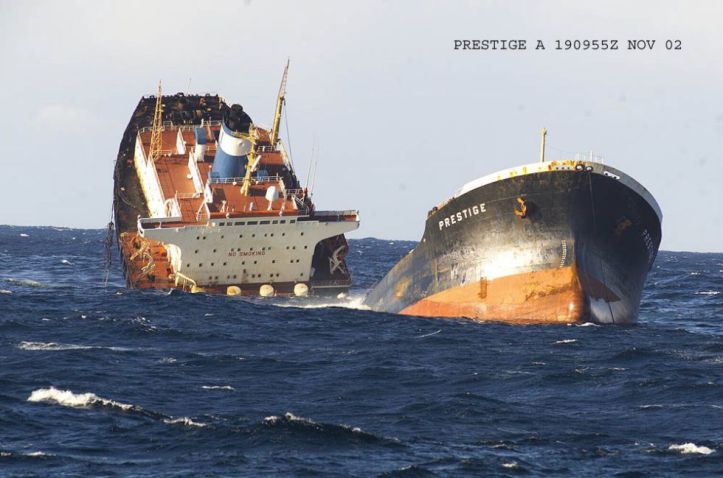 On November 13, 2002, one of tanks of the Prestige burst during a storm off Galicia, in north-western Spain. The Greek-operated single-hulled oil tanker was carrying a 77,000 metric tons cargo of heavy fuel oil. At around 8:00 AM on November 19, the ship split in half and sank, releasing the oil into the sea. The spill polluted thousands of kilometres of coastline and more than one thousand beaches on the Spanish, French and Portuguese coasts, causing great harm to the local fishing industry. It has been the worst oil spill in Spain’s history.
On November 13, 2002, one of tanks of the Prestige burst during a storm off Galicia, in north-western Spain. The Greek-operated single-hulled oil tanker was carrying a 77,000 metric tons cargo of heavy fuel oil. At around 8:00 AM on November 19, the ship split in half and sank, releasing the oil into the sea. The spill polluted thousands of kilometres of coastline and more than one thousand beaches on the Spanish, French and Portuguese coasts, causing great harm to the local fishing industry. It has been the worst oil spill in Spain’s history.
A key issue raised by the Prestige incident was whether classification societies can be held responsible for the consequences of incidents of this type. In May 2003, the Kingdom of Spain brought a civil suit in the Southern District of New York against the American Bureau of Shipping (ABS), the Houston-based international classification society that had certified the Prestige as “in class” for its final voyage. Spain’s original damage claim against ABS was some $700 million.
Ten years after the sinking of the Prestige oil tanker off Spain, on October 16, 2012, the captain, Apostolos Mangouras, his chief engineer and the former head of Spain’s merchant marine department went on trial. Last week, a Professor of Physics at the University William Mary in Virginia, Alfred R. Osborne, testified at the trial as an expert in defence of the captain. He explained that an abnormal wave could have been the cause of the accident.
Sailors often whisper of monster waves when ships sink mysteriously. For years oceanographers dismissed sailors’ reports of rogue waves much as they did stories of mermaids. Marine scientists clung to statistical models stating that monstrous deviations from the normal sea state occur once every 1,000 years. However, recent evidence and experimental studies support the idea that these waves might not be as abnormal as once thought. In 1995 an oil rig in the North Sea recorded a 25.6-metre wave. Then in 2000 a British oceanographic vessel recorded a 29-metre wave off the coast of Scotland. In 2004 scientists using three weeks of radar images from European Space Agency satellites found ten rogue waves, each 25 metres or more high.
Physicists have known about these solitary waves for much longer. In 1832 the Scottish engineer John Scott Russell was riding along a canal in Edinburgh when he saw a bow wave form behind a horse-drawn canal boat. It moved “at great velocity, assuming the form of a large solitary elevation, a well-defined heap of water which continued its course along the channel.” Russell followed the wave on horseback for nearly two miles. It never changed shape or slowed down.
This kind of solitary wave is known as a soliton, a self-reinforcing wave packet or pulse that maintains its shape while it travels at constant speed. Solitons are caused by a cancellation of non-linear and dispersive effects in a medium. Since Russell’s discovery, scientists have found solitons everywhere there is wave motion: in fibre optic cables, in the electrical activity of cardiac tissue or in the electromagnetism that affects the ionized gases, or plasma, that make up most of the visible universe.
Professor Osborne has studied rogue waves for 20 years, and he is now writing a book to be published in 2015: “The Sinking of the Prestige: Were Rogue Waves Responsible?” which provides a broad understanding of rogue waves and their effects on ships and the oil industry. Rogue waves are also known as freak waves, monster waves, killer waves, extreme waves, and the like. Osborne says that rogue waves lie somewhere in the hierarchy between sine waves and solitons.
Doesn’t it all ring a bell? Change the scenery: instead of the ocean and the Prestige, the financial system and Lehman Brothers; instead of American Bureau of Shipping, Standards and Poor’s; instead of a freak wave… While reading all this, I have the feeling that sailors and ship-owners have a lot more imagination than Wall Street’s white collars and Spanish savings banks’ dull administrators who, so far, have not been able to invent their own statistical monster to justify the financial tragedy. Come on guys! Hire a physicist to put a little colour into your boring narratives of financial debacle.
____________________
 Kelly McNeill, Killer Wave, Fine Art America
Kelly McNeill, Killer Wave, Fine Art America